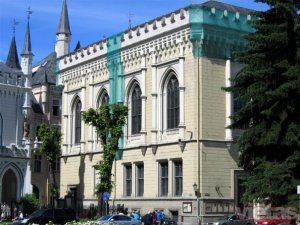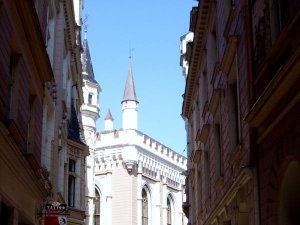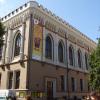|
SHARE THIS CONTENT
Tweet
Contacts
Description
One of the oldest and most interesting buildings in Riga is the Great Guild, which was built in 1858 and is located between Zirgu, Amatu and Kaleju streets. In 1282 Riga joined the North German city trading union Hansa. The Hanseatic League governed all trade along the Baltic seacoast and it founded the Guild of the Holy Spirit, which took on merchants and craftsmen. Gradually the Guild of the Holy Spirit divided into two groups, which historically came to be known as two rooms and took their names from German cities —the Muenster Room and the Soest Room. It is assumed that Riga’s first immigrants came from these two cities. Later both organisations of the Guild were separated according to economic and social interests: German merchants met in the Great Guild Muenster Room, and German craftsmen met in the Small Guild Soest Room. In 1354 the joint merchants adopted organisational statutes in the Muenster Room, and therefore this is considered to be the year of its foundation. The Guild’s court took up an entire block at the end of Amatu street by Kaleju street. A Franciscan monastery had been located next to the Guild’s court since 1258. Its proximity created a legend that the meeting places of both Guilds were located in parts of the former monastery and that the Great Guild’s meeting hall had formerly been the monastery’s dining hall. The Guild’s court was separated from the rest of the city by the Guild’s gate, which was demolished in 1863. Engraved plaques, which were attached to the Guild’s gate, were fixed into the building’s outer wall on both sides of the entrance from the courtyard. Over the course of the centuries, the Great Guild building has been enlarged several times. The most significant change to the exterior was made in 1697, when a beautiful Baroque facade was erected; the interior was altered repeatedly, in order to adapt to the building’s various functions. Feasts and banquets, including wedding celebrations, took place here regularly. The old building of the Great Guild was a two-storey stone structure, and in 1853 it was rebuilt. The new building was much larger, and occupied up the entire area from the courtyard to Kaleju street. The new building encompassed the virtually unaltered old Guild meeting hall (Muenster) and the bride’s chamber (Fireplace Hall). The Muenster Hall, which was built in 1330, is still located in the Great Guild even today. It is the oldest section of a public building in the Baltic States, because when the current Great Guild was built a hundred years ago, the old meeting hall was incorporated within the structure that surrounded it, preserving the old window apertures in the wall between the halls. It is amazing that despite repeated reconstructions of the building, Muenster Hall has been preserved in its original form up until today, with its Gothic cross arches, central stone pillars, musicians’ balcony built in 1646, where city musicians used to perform, and the coats-of-arms of the Hanseatic cities, which were painted on the walls in 1898. Only a few pieces of art — sculptures and silverware — that were formerly in the Hall are now missing. A statue of the Madonna, created in 1488 and called “Docke” was particularly famous.
Inside the Fireplace Hall is a fireplace made of sandstone in 1633. On it is a relief of an arched room portraying the figures of a dying king and his sons, who are listening to their father’s last lesson—to live together harmoniously like a bundle of sticks, which cannot be broken, unlike an individual stick that can break easily. Under this sculpture is a couplet in German that reminded the Great Guild’s elders of a truth: “Do not say what people like to hear,
On top of the old halls, There were plans to build a large and spacious hall in the 19th century above the old halls, which would occupy the entire top floor. The fate of this hall has been varied. In 1936 the Great Hall, with its splendid woodwork interior, was adapted for the needs of a Congress Hall. Unfortunately it was ruined by fire in 1963. As the Great Hall had been the Latvian Philharmonic’s concert hall since 1941, it was rebuilt after the 1963 fire as a concert hall in accordance with the project by architect M. Gelzis. In the summer of 1998, architect L. Markova successfully combined the 19th century window apertures, stage and ceiling panels from the 1960s with an antique wall colouring. Another noteworthy stained glass composition is in the annexed entrance hall on the second floor, which is called the Stained Glass Hall. In 1936 A. Cirulis created four scenes in these stained glass windows that depict important activities in Riga. Nearest in category(-ies):
|
||||||||||||||||||||||||||||||||||||||||||||||||||||||||||||||||||||||||||||||||||||||||||||||||||||||||||||||||||||||||||||||||||||||||||||||||||||||||||||||||||||||||||||||||||||||||||||||||||||||||||||||||||||||||||||||||||||||||||||||||||||||||||||||||||||
| © 2005-2024 SIA VIETAS |
|












